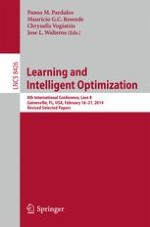2014 | Book
Learning and Intelligent Optimization
8th International Conference, Lion 8, Gainesville, FL, USA, February 16-21, 2014. Revised Selected Papers
Editors: Panos M. Pardalos, Mauricio G.C. Resende, Chrysafis Vogiatzis, Jose L. Walteros
Publisher: Springer International Publishing
Book Series : Lecture Notes in Computer Science
